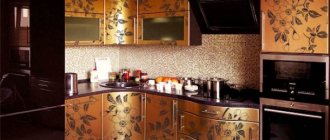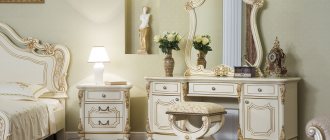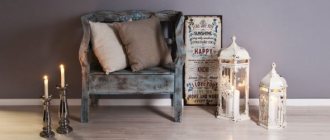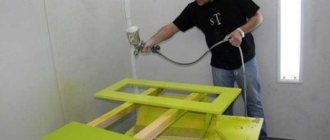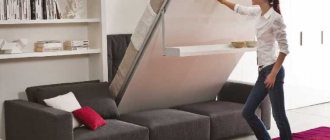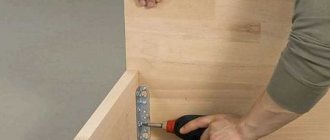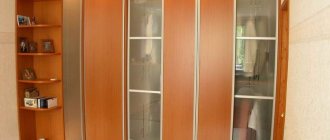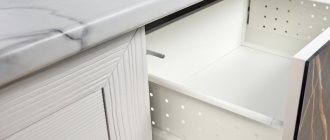Details of cabinet furniture and their names
The main details of cabinet furniture are quite easy to remember, the names of the furniture parts speak for themselves, these are the sides, bottom, lid or tabletop, back wall, drawer or plinth, and in some cases shelves, doors, also known as facades, drawers, dryers, handrails and things like that.
The parts are divided into two main types: the first type is the parts that form the furniture frame, the second type is those furniture parts that are installed directly on the already assembled frame. As an example, let's look at what parts a kitchen table consists of. The parts that form the frame of the furniture in this case are the sidewalls (No. 1), the back wall (No. 2), the drawer or base (No. 3) and the bottom (No. 4), it is also worth noting the important role of the tabletop (not shown in the figure) in this design it must be rigidly fixed either to dowels or to corners. In our case, the additional parts installed on the assembled furniture frame are the remaining doors (no. 5), shelves (no. 7) and drawers (no. 6).
And, by the way, if the desire to acquire new furniture is due only to the desire to update the kitchen, although the old one is functionally satisfactory, it’s probably worth thinking about changing only the hanging parts of the facades, handles and other things. Functionality is another matter - here it’s worth thinking about a complete remodel or adding some furniture elements.
Let's return to the topic of frame furniture details and consider the features of each of them.
Detail of cabinet furniture - Sidewall.
The length and width of the sidewall determine the height and depth of your table, and while you can experiment with depth, an incorrectly selected table height can make it extremely uncomfortable. Among the design features, it is worth noting the need to cut off the corner in the far lower corner of the sidewall, otherwise the table will rest against the baseboard, which will not allow you to move the table close to the wall.
Detail of cabinet furniture - Back wall.
Typically made from fiberboard or treated fiberboard. The width of the back wall is made three millimeters less than the width of the table and, when fastening, they retreat approximately one and a half millimeters on each side. The height of the back wall of the kitchen table should also be shorter, but by 1 - 2 millimeters from the edge of the bottom to the tabletop (there is no need to cover the space behind the console with the back wall). In the lower part you also retreat from the edge of the bottom, but in the upper part it is advisable to make it flush with the sides. The back wall is attached to the furniture parts using ordinary small nails (like post nails), take my word for it - this fastening is enough.
Detail of cabinet furniture - drawer, console.
In most cases, the height of this part is approximately 10 cm. This size of the furniture is due to the fact that the drawer, together with the back wall, prevents our structure from diagonal deformation (in other words, it does not allow it to fall on its side). The width of the console is equal to the width of the table minus the thickness of the two sides. The console is attached tightly between the sidewalls; it is advisable to use Confirmat furniture screed for fastening. In many designs, the drawer is installed flush with the doors, which in my opinion is wrong because when approaching the table you will constantly rub your shoes against the drawer, so it is worth recessing it somewhat inside the table. Installing a drawer at the bottom of the table is traditional, but not at all necessary, so the following figure shows the use of a drawer in place of the console, which can either be attached to the sides or have its own wheels; in the latter case, it is possible to store heavier things or, for example, potatoes. The console in this design is installed at the top of the table.
Detail of cabinet furniture - bottom.
The detail is simple but irreplaceable. The dimensions of the bottom correspond to the depth of the table and the width minus the thickness of the two sides. The bottom is tightly fastened between the sidewalls; it is advisable to use Confirmat furniture screed for fastening.
Details of cabinet furniture - doors.
Doors, or facades, are a separate big topic that we will talk about next time. In this case, we will only touch on the dimensions of the door. The width of the door corresponds to half the width of the table minus five millimeters. (4 millimeters on the edges (2 mm on each side) and one millimeter on each door for the gap between them). The height of the door depends on the presence of drawers in the design, in the presence of which it is necessary to take into account a gap of 2 millimeters with the mating parts of the furniture.
Details of cabinet furniture - drawers and shelves.
Everything is simple with the shelves; their size corresponds to the size of the bottom. It is advisable to attach it to corners, furniture dowel dowels or special holders for shelves. Boxes are a kind of separate design and therefore we will devote a separate topic to them.
In this case, we have not considered all the details of cabinet furniture, but only the main ones, which I hope will be enough to assemble furniture with your own hands for your home and garden.
Source: ptexpert.ru
Brief outline of the history of furniture development
Buffet (French) – a cabinet for storing dishes, table linen, snacks, drinks.
Bureau (French) - a type of desk with a retractable lid and drawers for storing papers. Depending on the purpose, there are office bureaus, supplier bureaus, secretary bureaus, and closet bureaus.
Hanger - a shelf or rack with hooks or pegs (as well as a separate hook) for hanging dresses and hats.
Showcase (French) – a glazed box, cabinet for displaying museum exhibits.
Wardrobe (French) – a wardrobe for clothes.
Sofa (pers.) – a type of furniture of large size, soft, semi-soft and hard, for sitting and lying.
How does is called? Dictionary of furniture items.
Different peoples created furniture and, of course, gave it different names in their own languages. The range of furniture is characterized by great complexity and diversity. Currently, many words are simply outdated and not everyone can easily determine the exact name of pieces of furniture. Here's a quick dictionary of the most commonly found pieces of furniture.
— Mezzanine is a superstructure in the form of cabinets above furniture with an independent door system.
— A banquette is a light oblong bench without a back or armrests, with soft upholstery, originally for ballrooms and recreation rooms.
— Bar — furniture for storing drinks and drinking utensils.
— Bergere is a cozy soft chair with a wide back that goes into the armrests and an additional pillow on the low seat.
— Library is a storage system or single cabinet for storing books. May be closed or open.
- Buffet - cabinet furniture, a high or low cabinet with compartments for storing dishes, cutlery, and drinks.
— A bureau is a desk with a desk that has several small drawers and compartments for storing papers and small items. The upper part is usually closed with a retractable curtain.
— A showcase is a glass cabinet designed for storing and displaying expensive dishes and various collectibles.
— Wardrobe - a large closet for clothes or a separate room for storing clothes.
— A set is a complete set of items of the same sample, style, and material.
- Geridon - a table or decorative stand resting on a column leg.
— A sofa is a type of upholstered furniture for sitting and lying with a back and armrests.
— A jardiniere is a type of shelf or basket for flowers, as well as a table for indoor plants. Often with a metal base.
— A canape is a small sofa with a raised headboard, a back and armrests, most often with upholstery. Types of canapés - ottoman and chaise longue.
— Kassa-punka is a bench-chest or seating bench with a drawer at the bottom, in most cases with a wooden back. An invention of the Italian Renaissance. The predecessor of the canapé.
- Cassone - (from Italian Casso - box) chest-chest for clothes, fabrics, linen and household utensils, common in Italy in the Middle Ages and the Renaissance.
— Chassis — (from the French La Causette — light conversation) a small couch or sofa for two, a version of a canapé.
— A chest of drawers is a low cabinet with drawers for storing linen, small household items, toiletries, etc. Invented by cabinetmaker Charles Boullée in 1690 for the royal bedroom.
- Console - (from the French Console - bracket, support) a small table or shelf protruding from the wall and attached to the wall, in the modern version - a narrow wall table.
— Kotntorka is a high desk with an inclined board and drawers, at which one works standing or sitting on a high chair.
— An armchair is a type of chair with handles for supporting the elbows. Seating furniture, usually with upholstery, backrest and armrests.
— Compartment — (wardrobe, sliding doors) the principle of opening doors, in which they move to the sides along special guides.
— An ottoman is a wide soft sofa with pillows replacing the backrest. It does not have a back or armrests.
— A semi-chair is a chair with armrests.
— Pouf is a soft low stool.
— A secretary is a type of desk with a hinged lid, drawers and shelves for storing papers and books;
— A sideboard is a small, low buffet for storing dishes and table linen, a type of buffet.
— Sofa - a wide and deep sofa with armrests at the same level as the backrest
— A rack is a device for storing something in the form of a series of shelves located one above the other.
— An ottoman is a wide and low sofa without a back.
— A bookcase is a free-standing structure made of open shelves fastened with racks and legs.
Furniture dowel
This type of fastening is rarely used on its own in the modern furniture industry. It is mainly used only to impart rigidity in conjunction with eccentric couplers.
Its main function in most cases of furniture construction is to prevent the panels from moving relative to each other and giving additional rigidity to the fastening.
Usually used in conjunction with an eccentric coupler. It is made from hard natural wood and has a cylindrical shape. This is a very simple and cheap part that has been used in wooden joints since time immemorial.
Craftsmen and carpenters who work with wood use furniture dowels as the main fastening element. In this case, the furniture parts are connected to dowels, which are glued to the parts using PVA glue. In this case, using any other screeds together with PVA no longer makes sense.
Screw tie
The screw coupler consists of a screw and a barrel. This kit is used to attach the end of one panel to the face of another. For example, for attaching a shelf to a side panel or a headboard to the drawers.
This is a very strong fastening due to the large tightening stroke. The only drawback of this fastener is that the screw head is visible from the front of the panel.
You can, of course, close them with special plugs, but this is also not a panacea. The plugs on the outer panel of the cabinet do not look aesthetically pleasing.
Installation of this type of fastener requires skills. Beginners may encounter such a problem as inaccurate alignment of the barrel holes with the hole in the end of the shelf, and it is not so easy to remove the unwanted barrel from its nest.
But the inconvenience during assembly and aesthetic errors are more than compensated for by the reliability and durability of the connection.
Confirmat
The most common and easiest to use type of furniture connection is the confirmat, which allows you to fasten several parts together at right angles .
In order to tighten furniture elements, you should drill 2 holes:
- the first - under the head of the confirmat (in one piece),
- the second - under the threaded part (in another part).
As a rule, such fasteners are used to connect parts made of solid wood or chipboard (chipboards), and dowels are used in combination with it, acting as guides.
| Album | Confirmat |
| Album | Confirmat |
In addition, there are different types of fasteners, so after installing it you will need to use special plugs to hide it from prying eyes and give the furniture an aesthetic appearance.
Conical coupler
The conical tie is often used for fastening thick chipboard panels (25 mm, 38 mm) and assembling frame facades on tie bars.
One of its advantages is the absence of visible caps on the front side of the panels. Unlike the screw in a screw tie, the rod used in a tapered tie is screwed into the panel. The screed itself has 2 holes. One is for the rod, which is screwed into the panel layer. The second is for the conical tie screw. The disadvantage of this type of fastener is the small tightening stroke. Under heavy loads, the holes for the rod screw may become loose over time. Then the screed will simply stop working!
LLC Svoy Master & PoliStyle
Articles:
FURNITURE TERMS.
Chair gas lift (gaslift) is a gas-lubricating shock absorber that regulates the height of the chair.
Chipboard – chipboard. It is made from various types of wood (non-industrial wood, waste from sawmilling, woodworking, plywood production, technological chips obtained from logging waste). Urea-formaldehyde resins are mainly used as binders when hot pressing boards. Flat-pressed chipboards are characterized by a density of 550.850 kg/m3. For use in furniture production, chipboard also has a decorative coating of films, veneer, laminated paper (laminate) and varnish. Often, the outer layers are denser, finely dispersed shavings. Waterproof chipboard has a characteristic greenish color when cut.
The frame is an element that gives the table structure rigidity and strength. Among operational furniture from domestic manufacturers, the most common is the panel version, in which the role of the frame is played by wide supports made of chipboard and a front panel.
Conference chairs are meeting chairs with legs or runners. The frame elements of such models are slightly smaller in diameter than the supporting structure of the work chair. Very often, the design of conference chairs includes all kinds of writing devices.
Caching is the process of covering a board (for example, fiberboard, chipboard, MDF) with paper-resin films under the influence of temperature and pressure, followed by curing of the adhesive layer. Depending on the temperature, there are cold, warm and hot caching. In terms of coating strength, cached furniture is significantly inferior to products coated with melamine.
Laminate is a multilayer coating consisting of a decorative layer of paper and a protective layer of resin. Fixing the film on the plate occurs due to the completion of chemical transformations of the resin contained in the film. The method of film attachment can be hot or cold. During hot lamination, the adhesive base of the film is activated by the heat and pressure of the laminator's pressure rollers. During the cold process, the laminator acts as a press. In addition to the decorative function, it serves to protect furniture elements from impact, moisture and temperature.
Lamination is the lining of a wood board with a paper-resin film with incomplete polycondensation of the resin. Fixing the film on the plate occurs due to the completion of chemical transformations of the resin contained in the film. The method of film attachment can be hot or cold. Cold lamination is a coating process without heating. In this process, the laminator acts as a press. During hot lamination, the adhesive base of the film is activated by the heat and pressure of the laminator's pressure rollers. The melamine resin contained in the porous surface of the paper polymerizes and penetrates into the chipboard structure at the capillary level. A homogeneous surface layer is formed, which has high technological and decorative properties: strength, water resistance, durability, resistance to high temperatures, wear resistance, smoothness and brightness of colors.
Laminated chipboard is a board with a protective coating of special decorative paper impregnated with melamine resins (which is why the term “melamine board” is often used). The laminated board has high moisture and heat resistance, and is also very resistant to abrasion and other damage.
Solid wood (solid wood) – furniture made from panels glued together from solid wood blocks.
MDF (medium density fiberboard) is a material that is a compressed fine fraction of wood. It is made from dried wood fibers treated with special binders, followed by hot pressing to a density of 700.870 kg/m3. Environmentally friendly material: production technology eliminates the use of epoxy resins and phenol that are harmful to health. MDF boards are resistant to moisture, easy to paint, laminate and process, which allows you to create products of complex shapes. Products made from this material look beautiful and unusual; furniture acquires rounded corners, panels, etc.
Melamine is a material used for finishing table tops and other wooden furniture parts. When making a melamine coating, a sheet of decorated paper (about 3/10 mm thick), impregnated with resin, is placed on a panel of chipboard or MDF. Polymerization takes place under pressure at a temperature of 180-200°C. Melamine is resistant to scratches and abrasive wear.
Cladding – covering a surface made of chipboard, MDF, etc. other material (natural veneer, film, plastic, etc.) that improves its appearance, consumer and other properties.
Euroscrew
This fastener is often used for assembling kitchen furniture modules and in economy class furniture. Just like with a screw tie, Euroscrew heads or plugs are visible on the front side of the side panel of the cabinet.
It screws into the end of the shelf with a pre-drilled hole. This screed also belongs to the economy class. To install it, 2 holes are drilled - into the end of the shelf and into the face of the part. They are attached perpendicular to each other. The most commonly used euroscrews are 7 mm in diameter and 50 or 70 mm in length.
This screed has 2 significant drawbacks:
Firstly, the outer side of the cabinet, if there are many shelves behind it, as a rule, is all “disfigured” with caps or Euroscrew plugs. Therefore, these fasteners are used in economy furniture. In kitchens, this drawback is hidden thanks to the cabinets standing in a row.
Secondly, furniture assembled with euroscrews cannot be disassembled and reassembled more than 3 times, since screwing the tie into the end of the shelf destroys its internal structure.
Eccentric coupler
One of the most popular types of fasteners today. All high-quality furniture is assembled on an eccentric screed (minifix). Its operating principle is as follows: an eccentric rod is screwed into the face of the part to which another panel will be attached at the end, into which the eccentric itself is screwed through the end of the other shelf, and then the eccentric turns the rod into itself.
An eccentric tie is always used in conjunction with a wooden dowel, which was described earlier. The dowel provides additional rigidity to the assembly and prevents the fixed panels from moving relative to each other.
Furniture assembled on this screed can be disassembled and assembled an unlimited number of times! There are different diameters of the eccentric itself: 25, 15, 12 mm. More common is an eccentric with a diameter of 15 mm.
Since the eccentric itself is visible on the side panel, plugs are provided for it to match the color of the panel. One of the disadvantages is the weakening of the tie in the event of spontaneous rotation of the eccentric.
To avoid this, some hardware manufacturers have provided notches directed in the opposite direction from its rotation during installation, which enhances adhesion.
Types of eccentric couplers
As practice shows, furniture is assembled and disassembled with great difficulty if all the fasteners in it are metal ties, described above. Let’s say that in order to remove one shelf, you practically need to disassemble half the cabinet. For horizontal parts (shelves), it is more convenient to use eccentrics, which allow you to place horizontal parts in an already assembled furniture box. Their operating principle is the same as that of the previously described eccentric coupler.
The only difference is that the eccentric, located in the shelf, fits onto the rod screwed into the face of the sidewall from above and there is no need to disassemble half the cabinet for this. In some factories, this type of fastener is called a shelf holder, since it is intended only for horizontal parts. Horizontal shelves assembled using these ties further tighten the joint, which increases the rigidity of the entire furniture frame.
Repeated dismantling and installation of furniture on such fasteners does not lead to wear of the connections.
Source: dd-space.com
Design features
The standard dimensional position for all products is height. It varies between 70-78 centimeters from the floor to the top plane of the tabletop. The width and length parameters will depend on the number of people for whom the table is being made. In this regard, it is taken into account that each person will need a plot 60 centimeters wide. Based on this position, dining tables for two people usually measure 60x90 centimeters. If a piece of furniture is made for one person, then parameters of 45x75 centimeters are suitable.
Standard sizes and types of kitchen tables
There are many design models of tables, among which there are both simple and very complex options.
- Traditional. This is a model of the so-called table on an underframe. The last element consists of four boards (tsargi), connected to each other into a rectangular box. The underframe is the base of the tabletop. In this case, the drawers are sometimes tightly connected to the legs, then the tabletop is made as a separate element, attached to the underframe with removable fasteners, for example, bolts. This option is stable, but if it is necessary to remove or bring the table out of the kitchen, consumers are faced with a problem, since the base of the structure (legs and base) may not fit through the doorway. The second option is that the underframe is tightly attached to the tabletop, and the legs are fixed to it with disconnecting fasteners. Disassembling the table - five elements: table top and four stands. When disassembled, this design is much more mobile than the first.
- Beam. This is a table model where a horizontal beam is installed between two double legs. It keeps the table legs at a certain distance from each other and makes the overall structure more stable. The tabletop is attached simultaneously to both the posts and the beam, but in some designs only to the legs. The advantages of this option are a 100% assembly design that can be assembled and disassembled without tools. The disadvantage is the high consumption of material and the complexity of manufacturing the elements.
- Without a base. Industrial furniture manufacturers note that this is the cheapest option for making dining tables. Essentially, it is a table top to which the legs are attached. Both simple and cheap materials are used (for example, post-forming technology for the tabletop, and four racks made of metal pipes), as well as expensive and sophisticated ones (for example, solid wood from oak or exotic species).
- Book designs. As soon as such tables went on sale, they began to be in great consumer demand. When folded, this model is very compact, so it easily fits near the wall and resembles a cabinet. It folded out to full or half size. But during operation, significant shortcomings of the product were revealed: the legs always rest against the racks. In addition, the first models were equipped with legs - beams. They had a weak latch that held them in one position when assembled. A slight pressure with the foot moved the leg, the weak lock could not hold it, so the tabletop immediately folded, which caused dishes with food to be overturned.
- Wall. This type of dining table is called folding. Today it is found in small kitchens somewhere in dachas or cabins. The base of the support is hinges on the wall and folding legs (one or two), which are replaced by chains or cables attached to the wall on top of the tabletop.
Read also: Kitchen table standards - sizes, shape and location
The material from which the dining table is made must be durable and have qualities that will not allow it to change in size during use in the kitchen. After all, in this room there are constant changes in humidity and temperature. Therefore, it is better not to use pine or spruce for this piece of furniture. Under the influence of the above-mentioned loads, such wood will begin to warp, crack, and become covered with blue stains and rot. Therefore, for the manufacture of countertops, laminated chipboard or MDF is usually chosen. The latter is the main part around which the entire manufacturing process revolves. The best option is to buy a finished product.
Of course, you can purchase several boards and make a tabletop from them. This is an array that will last for many years, moreover, it has a natural texture that cannot be replaced by anything. But joining the boards together is a difficult and delicate process. This requires precise adjustment of the boards to each other. In addition, the work is carried out using special devices - clamps. An inexperienced furniture maker will not be able to work with them. Therefore, in most cases, they opt for postforming technology.
The furniture is assembled using dowels and confirmations. The first are wooden or plastic bars of round cross-section, which are inserted under pressure into the prepared blind holes of the furniture parts to be connected. Wooden models are placed on an adhesive composition to increase the strength of the joint. Confirmats are metal fasteners. A through hole is drilled under them from the front side of one assembly element, and the fastener is screwed into the end of the second element. This is clearly visible in the photo below.
Beginners in the construction business are recommended to use confirmations. The thing is that connecting with dowels requires the manufacturer of the work to be particularly precise in fitting the holes on the different planes being connected. Even a slight shift is a defect. To assemble simple dining tables, metal profiles are also used, with the help of which wooden structures are attached. In this case, fastening is done with wood screws.
Read also: How can you restore a table with your own hands?
Doors
Cabinet sliding wardrobes are equipped with sliding sliding panels in the front part. Such designs are convenient in small rooms to save space. Owners of modern spacious apartments prefer to build wardrobes along the entire wall. In this case, a continuous facade of a large area is formed.
A free-standing wardrobe or china cabinet is equipped with hinged doors. The part is intended to protect the internal contents and for decorative purposes. Door fasteners are selected depending on the type: hinged hinges or roller guides.
Facade
As a rule, wardrobe doors form the entire façade of the furniture. Other design solutions for the facade also include:
- fragments of decorative glazing;
- edges of open shelves;
- sheflots (front parts of drawers);
- decorative overlays (horizontal and vertical);
- cornices.
The concept of “façade” includes all visible elements extending into the side or frontal plane. The material, color and texture of the facade sets the style of the interior. It is possible to make sliding wardrobes from ready-made facades, which are sold in a wide range.
Back wall
The back wall covers the product from the back. The materials used are durable boards without decorative finishing: chipboard, HDF, DFPO.
If you need a service for making custom-made furniture in Moscow, you can contact our company. The website contains numerous photographs of models that we will produce according to individual sizes. We offer competitive prices for materials, fittings and work. The surveyor's visit is free.
Source: www.shkaflon.ru
Tips for choosing
You need to select components for sliding wardrobes based on the quality of the parts. The rigidity of metal products, as well as the smoothness and softness of the roller systems, determine the durability and ease of use of a piece of furniture. Door hardware must withstand daily loads, so you should not purchase cheap models. It is important that the internal content is properly planned. It is necessary to pay attention to the material of manufacture of all components. You should also consider the following recommendations:
- the size of the guides must correspond to the dimensions of the cabinet and the length of the doors;
- the rollers must ensure smooth and silent running;
- closers need to be chosen that will easily withstand the weight of the door leaf;
- sealants should not shrink or leave marks on the surface.
When choosing the main components, you need to pay attention not only to the quality of the material, but also to the reputation of the manufacturer. The design will last a long time if the components are selected in accordance with the dimensions of the product. You also need to know the rules for operating sliding wardrobes.
A sliding wardrobe is a universal piece of furniture in which you can store a huge number of things. It fits well into any interior and also helps to divide the space into zones. The correct choice of model will allow you to implement even the most complex project.
How to properly assemble a wardrobe with your own hands, step-by-step tips
The size of the guides must correspond to the dimensions of the facade
It is better to choose silent rollers
Closers must be able to withstand the weight of the door leaf
It is important that the seal does not shrink
Accessories
Furniture fittings are all kinds of fasteners, handles, curtains, supports and decorative elements. They are made of metal, wood, plastic and other materials. Metal products are treated with special anti-corrosion agents to extend their service life. For luxury-class designs, the fittings can be gold-plated or silver-plated, as well as trimmed with rhinestones, crystal or natural stones. Conventionally, fittings can be classified by type.
Connecting fittings – connects and fixes parts together. This group includes one-piece, detachable and movable elements:
- Permanent connections include screws, ties, screws, nails, bolts, brackets, hooks, upholstery buttons of upholstered furniture. The tie can be eccentric or connecting. Galvanized steel is used for the eccentric tie and makes it durable. The corner tie does not require additional holes in the ends of the furniture. Threaded ties include a nut and a screw that create a strong connection. A wedge coupler is also used for quick connection. It is based on plates, wedges and staples. The ties are connected with traditional screws;
- Detachable connections ─ these are door handles, latches, shelf holders, magnetic devices, locks, bolts. To fasten detachable structures, screws and self-tapping screws are used;
- Movable ─ these are hinges, “rails” for parallel movement of the door, microlifts. Pneumatic mechanisms and ball-bearing guides take on the entire load.
For furniture made from chipboards, it is not recommended to use piano hinges, which were used several decades ago. Today, manufacturers use four-joint designs called "frog". They can withstand a 10,000th door opening/closing cycle.
Rotating elements ─ these include carousel mechanisms, structures for moving tabletops apart, for directing the movement of products. For example, the shelf rotates along its axis and makes it easy to get the desired item. Basically, furniture structures are built using guide systems, which are used to pull out elements. They can extend fully or partially. Thanks to special rollers, such systems operate smoothly and almost silently. They are made of steel, fluoroplastic or duralumin. If we consider the importance of fittings as a percentage of the cost of cabinet, upholstered and kitchen furniture, we get the following results: in cabinet furniture, fittings account for 10-15% of the total cost of the product. For a kitchen, the importance of fittings is 25% of the cost of the set, and for upholstered furniture it is 30-40% of the cost of the product.
Accessories for assembly ─ when purchasing furniture, you need to pay attention to the accessories and upholstery fabric, determine their quality and strength. And also on the assembly details of the product, which include furniture corners, confirmants, rafixes, minifixes and dowels:
- Furniture corners are simple, cheap and affordable types of connections. On the construction market they are presented in different sizes, made of plastic and metal. Corners are designed for fastening hinged parts in pencil cases and cabinets. They are easy to install, have a low price, but are noticeable, which slightly spoils the design of the structure;
- Confirmat is a furniture European screw, which received its name from the German manufacturer. A furniture screw tie, consisting of a steel rod with a blunt ring, a head and a massive thread, is capable of connecting several wooden elements at once. The confirmation is visible in the design, so it is masked with a plug. The most common are screws with dimensions of 7x50 mm or 6.3x50 mm;
- A dowel is a connecting element that is used for assembling wooden, plywood, and chipboard furniture parts. It is made of hardwood and has a cylindrical shape with chamfers. Today plastic dowels are also produced. They strengthen furniture connections with confirmat, minifix and rafix. Used with PVA glue as an independent fastening element;
- Minifix ─ is an eccentric coupler for furniture joints, consisting of two parts ─ a rod and an eccentric. Minifix has a different design, which makes it possible to increase the length of the element and connect it at different angles. For installation, use a Ø15 mm cutter and drills, with which three holes are drilled. The fastening turns out to be complex and requires precise calculation;
- Rafix ─ is used in visible places to connect furniture parts of tabletops, side parts of furniture structures. It is installed on two holes, has an eccentric mechanism and a rod. Rafix has a beautiful aesthetic appearance, but it is not particularly durable.
Source: mblx.ru
Types of components
The quality of components for sliding wardrobes must be high. Each part performs its functions and is selected in accordance with the content and dimensions of this type of furniture. Homemade elements will lead to a reduction in the service life of products.
Sliding systems
Parts of sliding systems can be purchased separately, and sets are also available. They can be supported or suspended. The first version of sliding systems includes rollers with two guides and a profile for the frame. It is easy to install and has a high level of reliability. This type of sliding system is used if the doors are heavy. Hanging fittings consist of an upper guide, rollers, and stoppers. The profile is fixed on the top cover of the housing or attached directly to the ceiling.
Options for using a white wardrobe in the interior of different rooms
The wardrobe includes connecting elements and plugs. As for the materials for making profiles for door panels, it can be aluminum, plastic, steel. Each material has its own characteristics.
| Material | Characteristic |
| Aluminum | Mainly used for making rail supports. Such components are used most often, as they are practical, reliable and characterized by a long service life. |
| Plastic | This profile has a low cost, but its strength is not too high. It can be combined with a metal edging, which enhances the technical characteristics |
| Steel | Such door frames are characterized by high strength and durability. The cost of the material depends on the reputation of the manufacturer and may be deliberately inflated |
Aluminum profiles for door leaves are used even in large-sized structures. When choosing any component, you should not resort to the cheapest option, otherwise the cabinet will quickly stop functioning.
Aluminum
Plastic
Steel
Rollers
Rollers are a structural element that ensures the movement of wardrobe doors. They do not allow the canvas to slide along the guide without permission, and also facilitate the process of opening and closing. The movements are smooth and almost silent. Roller rims are made of plastic, rubber, Teflon or steel.
When used correctly, these elements can last for many years, since they are designed in such a way that dust does not get inside the mechanism. One way or another, in the event of a breakdown, installing new rollers for the wardrobe with your own hands will not be difficult at all. Thanks to this component, it is possible to adjust the position and height of the door leaves. The number of wheels is determined by the weight of the doors.
Rollers can be asymmetrical or symmetrical. The first option is used to move the door leaf along the lower guide profile. The second is characterized by fastening wheels on the lower and upper sides. It is intended for glass, mirror or plastic panels.
Asymmetrical
Symmetrical
Sealant
The seal is necessary to hide the gaps between the door leaf and the frame. It is attached to the side of the doors, ensuring a tight fit to the body. There are several types of products:
- Universal. Used when installing heavy doors.
- Silicone. This seal is not hazardous to health and ensures reliable fixation of the sashes in the profile frame.
- Brush. It consists of pile attached to adhesive tape.
Purpose of profiles for sliding wardrobes, overview of varieties
The width of the seal depends on the type of canvas and varies between 4–8 mm. The element comes with or without a self-adhesive base.
Universal
Silicone
Brush
Stopper and separator
The separator is more often used in designer models. It is made of glass, chipboard. The thickness of this fragment varies. A stopper is a component that secures the wardrobe door leaf in the right place, usually made of steel. The product has the shape of antennae and has high springy properties. The part must be installed in the lower guide profile.
Stopper
Delimiter
Retractable structures
The internal content of the wardrobe depends on how functional the furniture should be. Most often it is represented by retractable elements, for the use of which the following guides are installed:
- Roller. This type is the most common, but has a serious drawback - the elements are pulled out partially or completely. The maximum permissible load is 25 kg.
- Ball. There are small balls inside the profile, which ensure easy sliding of shelves or drawers.
- Tandems. The guides in this case are hidden inside the drawer. This system allows you to effectively use the entire internal space of the cabinet. It is expensive, but operates smoothly and silently.
- Metaboxes. In addition to guides, they include sidewalls made of plastic or metal. There are options that are put forward partially or completely. The height of the walls and the depth of the box may vary.
What accessories will be used depends on the financial capabilities of the people. Among the wide variety of elements, you can always find exactly what is suitable for a specific product model.
Roller
Ball
Tandem
Metabox
Additional items
It will be useful to supplement the furniture set with some practical details. A mezzanine for storing things that do not require constant access would not be superfluous. In addition, the cabinet may contain the following additional components:
- Shelves. There are retractable or fixed ones. The distance between them is about 30 cm. The first type is more convenient to use, but costs more.
- Drawers. A popular option is the full extension system, which provides easy access to everything. The height of the drawers is usually 20–30 cm. They are intended for laying out clothes that do not wrinkle.
- Barbells. They are used to store things on hangers or hangers.
- Pantograph. This is a device that extends the bar with clothes to a convenient level at a large height of the structure. The product can be mechanical or electrical.
- Shoe racks. They are mobile and mounted at the bottom of the wardrobe at a certain angle.
- Baskets. Most often they are retractable.
An additional element can be considered a crossbar to which hangers cling. It can also be fixed or retractable. In addition, the closet has a structure for storing ties, belts, and small items.
Shelves
Drawers
Barbell
Pantograph
Shoe rack
Baskets
